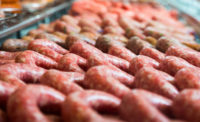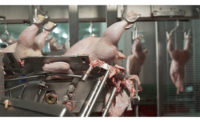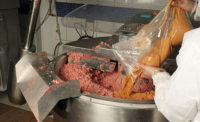While advances in bandsaws, slicers and other cutting instruments will likely add operational efficiencies and enhance product quality for adopters during the breaking down of primals, impediments remain. Issues include processors’ resistance to change to capital investment constraints, analysts say.
Many smaller volume operators cannot justify the often high expense of buying advanced cutting technologies, earmarking resources to properly maintaining and sanitizing them and training employees on how to use them correctly, says Norman Marriott, emeritus professor in the College of Agriculture and Life Sciences at Virginia Polytechnic Institute and State University (Virginia Tech), in Blacksburg.
“The meat industry is very competitive and works on a very narrow margin,” he says. “Many companies are not willing to risk something that may not prove to be successful.” The biggest processors with the largest volumes are better able to withstand losses from such investments, he says.
The possible toll of adopting new automation is a major operating challenge, says Angie Krieger, vice president of domestic marketing for the Des Moines, Iowa-based National Pork Board (NPB). “There are investment amounts with a lot of zeroes on the end of them,” she says. “But folks need to think long term about how the investment will not only pay off at the processing plant, but also create opportunities in the supply chain.”
Though he says it sometimes is easier for processors “to stay out and keep the system moving as is,” particularly because technology adjustments can impact processing partners, Jason Menke, NPB director of marketing communications says there can be major benefits from moving away from the status quo. The NPB advocates for changes in the sector in its recent Heads Up! position paper.
Weigh The Pros and Cons
While Krieger says many plants have older assets “and you may need to disrupt current operations in order to make some of these automated changes,” she adds that “there are great rewards in those risks.”
Such benefits from leveraging newer cutting technologies may outweigh the hazards, particularly if it results in successful plant robotization, analysts say.
“Mechanisms with the proper precision can provide better workmanship than plant personnel,” Marriott says. “The automated equipment is not subject to human error or carelessness and there are less interruptions because operators do not have to deal with workers leaving the production line to visit restrooms or having persons call in sick.”
He adds that automated machinery is a way for processors to compensate for industry labor shortages, and while variations in the size, shape and thickness of cuts makes it more difficult to use robotics and other standardized cutting technologies, greater carcass uniformity is occurring because of fewer animal producers in the sector.
Indeed, a 2017 report on improvements to robotic bandsaw operations commissioned by the North Sydney-based Australian Meat Processor Corp. (AMPC) reveals potentially strong paybacks from technology enhancements. The AMPC provides research, development and extension services that are intended to improve the sustainability and efficiency of the red meat processing industry.
The study states that robotic automation and hybrid processes for bandsawing have a wide array of advantages for the red meat industry, including lower production costs, reduced worker fatigue, increased workplace safety and hygiene, and higher throughput and yield through efficient cut placement algorithms and the precision control of the thin-kerf bandsaw blade.
Why sensors make sense
In addition, the report says that integrating sensors into bandsaws other meat processing equipment could enable users to better detect errors and have more accurate means for scheduling proactive care and monitoring employee performance. That includes tracking the number of cuts made and the speed and frequency of cut production in order to encourage efficiency and safe practices.
Such sensors also can monitor various aspects of saw health, such as power consumption, speed and tension, the report shows. “The integration of sensors into factory equipment allows for more informed energy analysis and preventative maintenance,” according to the report. “The provision of interface strategies for clearly conveying this data (and other relevant process information), ensures that factory personnel are aware of potential problems before they cause damage, and that they can correct them quickly in order to minimize costly downtime and delays.”
Sensors that integrate with an onboard computer, projection-mapped interface and cloud-based log linked to quick-response (QR) codes on the device will make the data immediately and intuitively accessible to machine operators and plant personnel on both the floor and offsite, the report adds.




